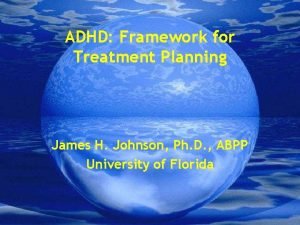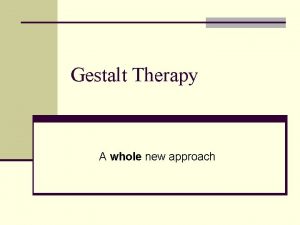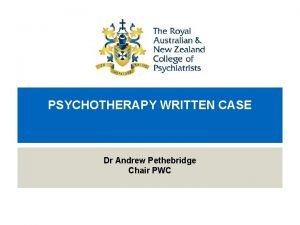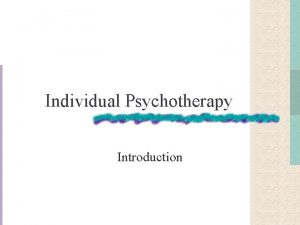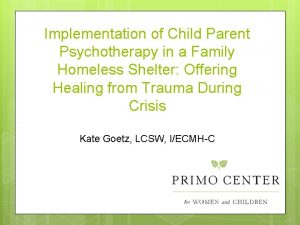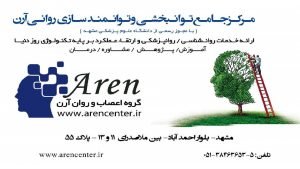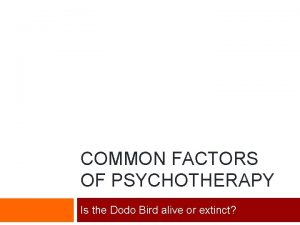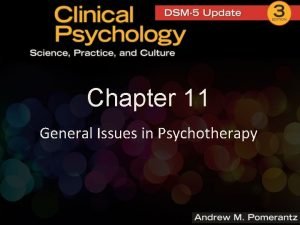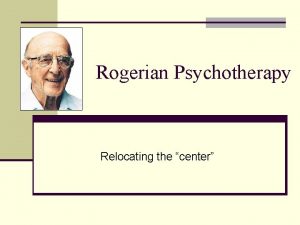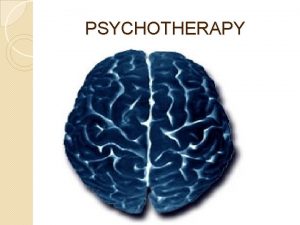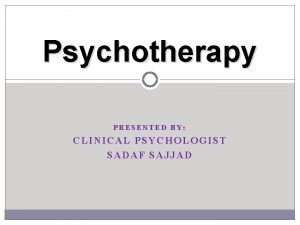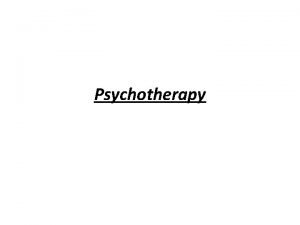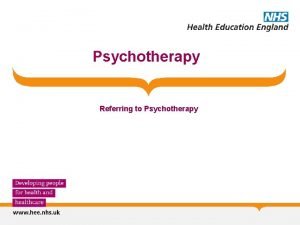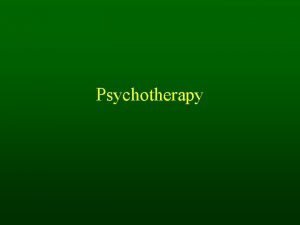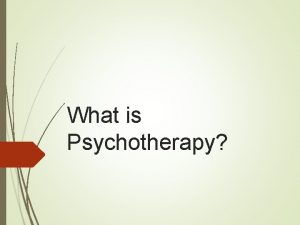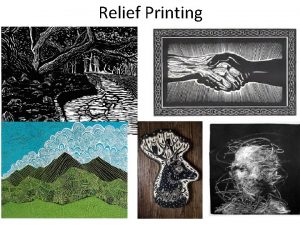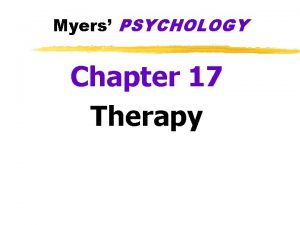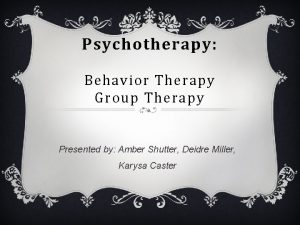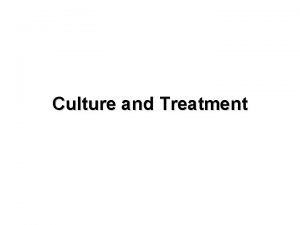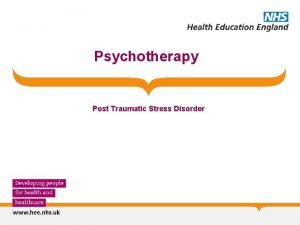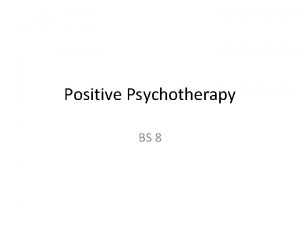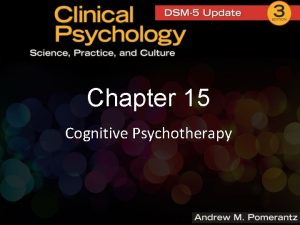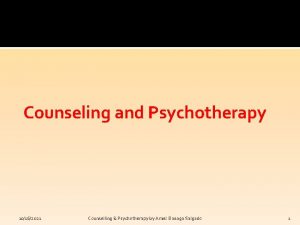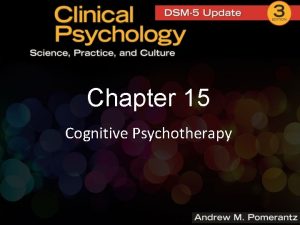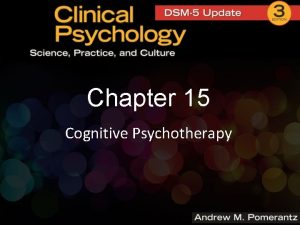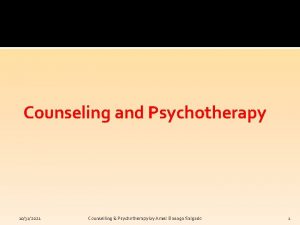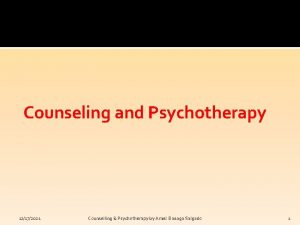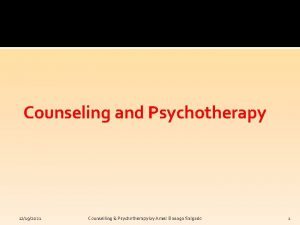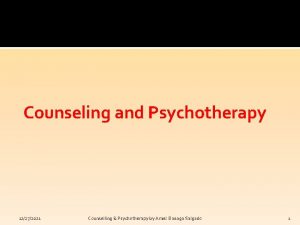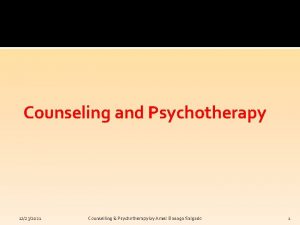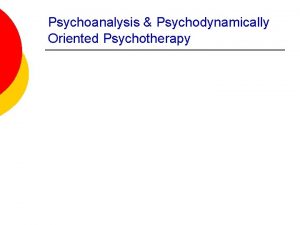Therapy Psychotherapy Goals Psychotherapy can provide relief to


























- Slides: 26

Therapy

Psychotherapy Goals Ø Psychotherapy can provide relief to a client for issues relating to: Disturbed thoughts Ø Disturbed emotions Ø Disturbed Behaviors Ø Interpersonal and life difficulties Ø Biomedical Disturbances Ø Which do you think is most common?

Myths of Psychotherapy Ø There is one best therapy Ø Therapy simply does not work Ø Therapists can “read minds” Ø People who go to therapists are crazy or just weak Ø Only the rich can afford therapy Is therapy expensive? Have you seen a counselor before?

Drug Therapy Biomedical therapy may administer drugs to improve abnormal behavior Ø Drug classes include: 1) Antianxiety drugs relieve anxiety. 2) Antipsychotic drugs improve thought processes, but they can have major adverse side effects 3) Antidepressant drugs can help with depression Ø If you were suffering from Major Depression, would you want to take medication, go to counselling or both?

Electroconvulsive Therapy Ø Electroconvulsive therapy (ECT) can alleviate profound depression ü Electrodes are used to pass electrical current through one of the brain hemispheres, thereby provoking a brain seizure (anesthesia is given to minimize trauma) ü ECT can lift depression ü How ECT lifts depression is unknown What have you hear about past uses of electroconvulsive therapy?

Psychosurgery Physicians have long recognized that the brain is key to the control of behavior ü Trephining: the opening of the skull to release evil spirits ü Roman Times: sword wound of the head was noted to relieve insanity ü 1940 s: Moniz argued that the frontal lobes could be surgically altered to alleviate mental illness 1) Lobotomy procedure cut fibers in the frontal lobes 2) Problem: patients were calm after the procedure but also had changed personality and drive Ø Do you think that there could be a future for psychosurgery?


Psychoanalysis, as devised by Freud, involves techniques that move issues from the unconscious to the conscious level for resolution Ø Therapy assumes that some issues may relate to childhood experiences 1) The ego serves to keep these issues below the level of consciousness (defense mechanisms) 2) Catharsis is an emotional energy that is released when early conflicts are relived Ø Do you think that simply identifying problems is the key to resolving them?


Psychoanalytic Techniques Moving issues from the unconscious to the conscious can be achieved through 1) Free association: patient says whatever comes to mind 2) Dream analysis: Dreams express unconscious issues ü Manifest content: the actual content of a dream ü Latent content: symbols that are disguised unconscious issues or motives Ø What might dreaming of falling represent?


Psychoanalytic Techniques 3) Resistance: Therapist looks for evidence that the patient is avoiding an issue 4) Transference: Does the patient treat therapist in ways that are similar to their parents? 5) Interpretation: Therapist provides analysis of the meaning of the thoughts, behaviours, and dreams of the patient – interpretation leads to understanding and resolution of unconscious issues Can you think of a topic that you avoid that upsets you?

Cognitive Therapies Ø Cognitive Therapy ü Assumes that problem behaviours and emotions result from faulty thought processes and beliefs ü Analyzes a person’s thought processes ü Attempts to restructure thought processes – changing thought patterns will in turn alter problem behaviours and emotions Can you identify something that you both believe and know to be untrue?

How can we combat this negative thinking?

Rational Emotive Model

Cognitive Therapy: Depression Selective perception: Depressed person focuses on negative events, while ignoring positive life events Ø Overgeneralization: Depressed person draws negative conclusions about their self-worth, based on minimal data – No one is talking to me right now, I must be unpopular Ø Magnification: Person magnifies the significance of a negative event – I failed the test, my life is over. Ø All-or-none thinking: Everything is good or bad Ø Do you focus on the negative or positive in your life?

Ø Do you focus on the negative in your life? Ø Can you think of an example where you over interpreted an event?

Humanistic Therapy Ø Ø Ø Rogers’s Client-Centered Approach Treats people as clients rather than patients Creates an atmosphere that emphasizes the clients’ tendency toward health Why do you think that people naturally move towards their problems when talking?

Ø 1) 2) 3) 4) Therapeutic techniques include: Empathy Unconditional positive regard Genuineness Active listening Why must a therapist be “real”

Behavior Therapies Ø ü The focus of behavior therapies is the use of learning techniques to change behaviors Therapist determines frequency of maladaptive and adaptive behaviors

Learning techniques are used to alter behaviors; these techniques include: 1) Classical Conditioning 2) Operant Conditioning 3) Modeling ü

Systematic Desensitization

Behavior Therapy Techniques Ø Classical conditioning: l Ø Operant Conditioning: l l l Ø Aversion therapy pairs an aversive stimulus with the unwanted behavior Shaping new behaviors Punishment: making an aversive stimulus contingent on the unwanted behavior Extinction: removing all rewards for the target behavior Modeling: client observes and imitates appropriate behaviors

Group Therapy Ø Ø 1) 2) 3) 4) Some approaches offer treatment to a group of persons rather than to one client Advantages of group therapy: Economy: group therapy is less expensive Group support: there is comfort in knowing that others have similar problems Feedback: group members learn from each other Behavioral rehearsal: group members can role -play the activities of the key persons in a member’s life

Therapy Cultural Universals Ø Naming the problem Ø Qualities of therapist Ø Establishing credibility Ø Placing the problem in a familiar framework Ø Applying techniques to bring relief Ø A special time and place

Lecture Review Ø Biomedical Therapies Ø Psychoanalysis Ø Cognitive Therapies Ø Humanistic Therapies Ø Behavior Therapies Ø Group and Family Therapy Which do you think is the best kind of therap. Y?
 Strategic goals tactical goals operational goals
Strategic goals tactical goals operational goals Strategic goals tactical goals operational goals
Strategic goals tactical goals operational goals Both psychoanalysis and humanistic therapy stress
Both psychoanalysis and humanistic therapy stress Bioness bits cost
Bioness bits cost Psychoanalytic therapy is to as humanistic therapy is to
Psychoanalytic therapy is to as humanistic therapy is to Adhd goals and objectives
Adhd goals and objectives Paradoxical theory of change
Paradoxical theory of change Objectives of play therapy
Objectives of play therapy Simplesetpro
Simplesetpro Frederick perls
Frederick perls General goals and specific goals
General goals and specific goals Examples of generic goals and product-specific goals
Examples of generic goals and product-specific goals Different between guidance and counselling
Different between guidance and counselling Ranzcp psychotherapy written case
Ranzcp psychotherapy written case Token economy in psychology
Token economy in psychology Types of individual psychotherapy
Types of individual psychotherapy Child parent psychotherapy triangle
Child parent psychotherapy triangle Cognitive psychology ppt
Cognitive psychology ppt Bracketing skills
Bracketing skills Dodo bird psychotherapy
Dodo bird psychotherapy General issues in psychotherapy
General issues in psychotherapy Who is carl rogers
Who is carl rogers Psychotherapy refers to
Psychotherapy refers to Sajjad urban dictionary
Sajjad urban dictionary Individual psychotherapy definition
Individual psychotherapy definition Quantum psychotherapy
Quantum psychotherapy The primary goal of cognitive psychotherapy is
The primary goal of cognitive psychotherapy is





